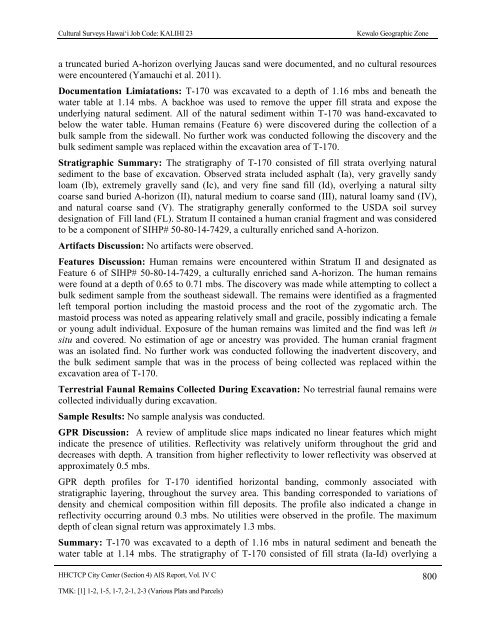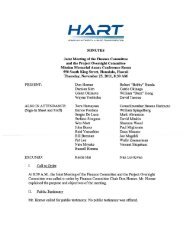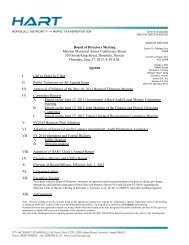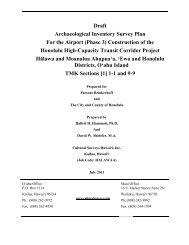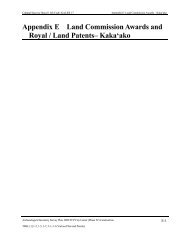4.12 Test Excavation 167 (T-167) - Honolulu Rail Transit Project
4.12 Test Excavation 167 (T-167) - Honolulu Rail Transit Project
4.12 Test Excavation 167 (T-167) - Honolulu Rail Transit Project
Create successful ePaper yourself
Turn your PDF publications into a flip-book with our unique Google optimized e-Paper software.
Cultural Surveys Hawai‘i Job Code: KALIHI 23Kewalo Geographic Zonea truncated buried A-horizon overlying Jaucas sand were documented, and no cultural resourceswere encountered (Yamauchi et al. 2011).Documentation Limiatations: T-170 was excavated to a depth of 1.16 mbs and beneath thewater table at 1.14 mbs. A backhoe was used to remove the upper fill strata and expose theunderlying natural sediment. All of the natural sediment within T-170 was hand-excavated tobelow the water table. Human remains (Feature 6) were discovered during the collection of abulk sample from the sidewall. No further work was conducted following the discovery and thebulk sediment sample was replaced within the excavation area of T-170.Stratigraphic Summary: The stratigraphy of T-170 consisted of fill strata overlying naturalsediment to the base of excavation. Observed strata included asphalt (Ia), very gravelly sandyloam (Ib), extremely gravelly sand (Ic), and very fine sand fill (Id), overlying a natural siltycoarse sand buried A-horizon (II), natural medium to coarse sand (III), natural loamy sand (IV),and natural coarse sand (V). The stratigraphy generally conformed to the USDA soil surveydesignation of Fill land (FL). Stratum II contained a human cranial fragment and was consideredto be a component of SIHP# 50-80-14-7429, a culturally enriched sand A-horizon.Artifacts Discussion: No artifacts were observed.Features Discussion: Human remains were encountered within Stratum II and designated asFeature 6 of SIHP# 50-80-14-7429, a culturally enriched sand A-horizon. The human remainswere found at a depth of 0.65 to 0.71 mbs. The discovery was made while attempting to collect abulk sediment sample from the southeast sidewall. The remains were identified as a fragmentedleft temporal portion including the mastoid process and the root of the zygomatic arch. Themastoid process was noted as appearing relatively small and gracile, possibly indicating a femaleor young adult individual. Exposure of the human remains was limited and the find was left insitu and covered. No estimation of age or ancestry was provided. The human cranial fragmentwas an isolated find. No further work was conducted following the inadvertent discovery, andthe bulk sediment sample that was in the process of being collected was replaced within theexcavation area of T-170.Terrestrial Faunal Remains Collected During <strong>Excavation</strong>: No terrestrial faunal remains werecollected individually during excavation.Sample Results: No sample analysis was conducted.GPR Discussion: A review of amplitude slice maps indicated no linear features which mightindicate the presence of utilities. Reflectivity was relatively uniform throughout the grid anddecreases with depth. A transition from higher reflectivity to lower reflectivity was observed atapproximately 0.5 mbs.GPR depth profiles for T-170 identified horizontal banding, commonly associated withstratigraphic layering, throughout the survey area. This banding corresponded to variations ofdensity and chemical composition within fill deposits. The profile also indicated a change inreflectivity occurring around 0.3 mbs. No utilities were observed in the profile. The maximumdepth of clean signal return was approximately 1.3 mbs.Summary: T-170 was excavated to a depth of 1.16 mbs in natural sediment and beneath thewater table at 1.14 mbs. The stratigraphy of T-170 consisted of fill strata (Ia-Id) overlying aHHCTCP City Center (Section 4) AIS Report, Vol. IV C 800TMK: [1] 1-2, 1-5, 1-7, 2-1, 2-3 (Various Plats and Parcels)


